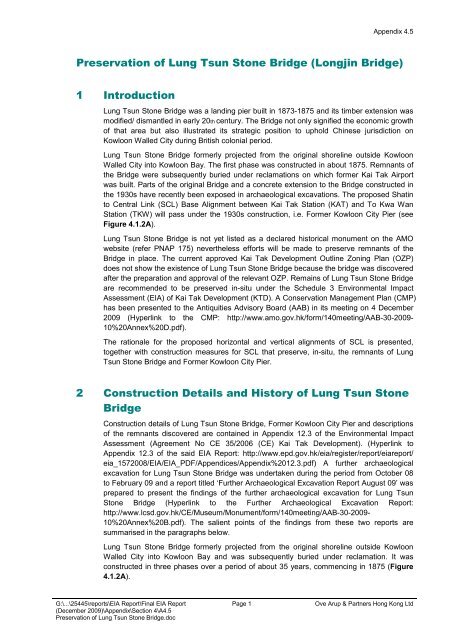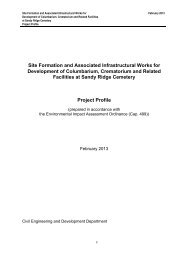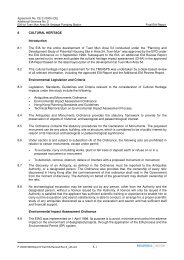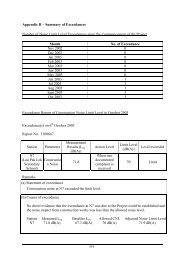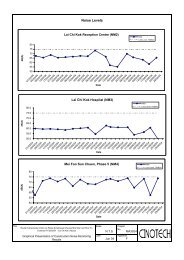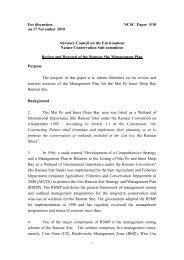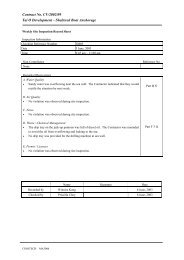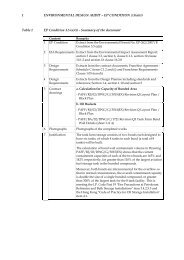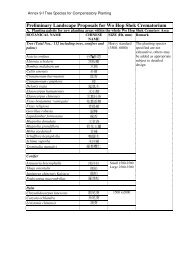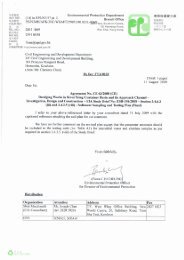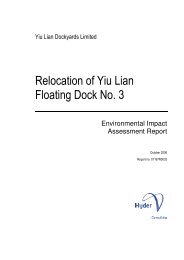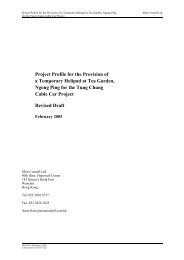Preservation of Lung Tsun Stone Bridge (Longjin Bridge) 1 ...
Preservation of Lung Tsun Stone Bridge (Longjin Bridge) 1 ...
Preservation of Lung Tsun Stone Bridge (Longjin Bridge) 1 ...
You also want an ePaper? Increase the reach of your titles
YUMPU automatically turns print PDFs into web optimized ePapers that Google loves.
G:\...\25445\reports\EIA Report\Final EIA Report<br />
(December 2009)\Appendix\Section 4\A4.5<br />
<strong>Preservation</strong> <strong>of</strong> <strong>Lung</strong> <strong>Tsun</strong> <strong>Stone</strong> <strong>Bridge</strong>.doc<br />
Page 1<br />
Appendix 4.5<br />
<strong>Preservation</strong> <strong>of</strong> <strong>Lung</strong> <strong>Tsun</strong> <strong>Stone</strong> <strong>Bridge</strong> (<strong>Longjin</strong> <strong>Bridge</strong>)<br />
1 Introduction<br />
<strong>Lung</strong> <strong>Tsun</strong> <strong>Stone</strong> <strong>Bridge</strong> was a landing pier built in 1873-1875 and its timber extension was<br />
modified/ dismantled in early 20th century. The <strong>Bridge</strong> not only signified the economic growth<br />
<strong>of</strong> that area but also illustrated its strategic position to uphold Chinese jurisdiction on<br />
Kowloon Walled City during British colonial period.<br />
<strong>Lung</strong> <strong>Tsun</strong> <strong>Stone</strong> <strong>Bridge</strong> formerly projected from the original shoreline outside Kowloon<br />
Walled City into Kowloon Bay. The first phase was constructed in about 1875. Remnants <strong>of</strong><br />
the <strong>Bridge</strong> were subsequently buried under reclamations on which former Kai Tak Airport<br />
was built. Parts <strong>of</strong> the original <strong>Bridge</strong> and a concrete extension to the <strong>Bridge</strong> constructed in<br />
the 1930s have recently been exposed in archaeological excavations. The proposed Shatin<br />
to Central Link (SCL) Base Alignment between Kai Tak Station (KAT) and To Kwa Wan<br />
Station (TKW) will pass under the 1930s construction, i.e. Former Kowloon City Pier (see<br />
Figure 4.1.2A).<br />
<strong>Lung</strong> <strong>Tsun</strong> <strong>Stone</strong> <strong>Bridge</strong> is not yet listed as a declared historical monument on the AMO<br />
website (refer PNAP 175) nevertheless efforts will be made to preserve remnants <strong>of</strong> the<br />
<strong>Bridge</strong> in place. The current approved Kai Tak Development Outline Zoning Plan (OZP)<br />
does not show the existence <strong>of</strong> <strong>Lung</strong> <strong>Tsun</strong> <strong>Stone</strong> <strong>Bridge</strong> because the bridge was discovered<br />
after the preparation and approval <strong>of</strong> the relevant OZP. Remains <strong>of</strong> <strong>Lung</strong> <strong>Tsun</strong> <strong>Stone</strong> <strong>Bridge</strong><br />
are recommended to be preserved in-situ under the Schedule 3 Environmental Impact<br />
Assessment (EIA) <strong>of</strong> Kai Tak Development (KTD). A Conservation Management Plan (CMP)<br />
has been presented to the Antiquities Advisory Board (AAB) in its meeting on 4 December<br />
2009 (Hyperlink to the CMP: http://www.amo.gov.hk/form/140meeting/AAB-30-2009-<br />
10%20Annex%20D.pdf).<br />
The rationale for the proposed horizontal and vertical alignments <strong>of</strong> SCL is presented,<br />
together with construction measures for SCL that preserve, in-situ, the remnants <strong>of</strong> <strong>Lung</strong><br />
<strong>Tsun</strong> <strong>Stone</strong> <strong>Bridge</strong> and Former Kowloon City Pier.<br />
2 Construction Details and History <strong>of</strong> <strong>Lung</strong> <strong>Tsun</strong> <strong>Stone</strong><br />
<strong>Bridge</strong><br />
Construction details <strong>of</strong> <strong>Lung</strong> <strong>Tsun</strong> <strong>Stone</strong> <strong>Bridge</strong>, Former Kowloon City Pier and descriptions<br />
<strong>of</strong> the remnants discovered are contained in Appendix 12.3 <strong>of</strong> the Environmental Impact<br />
Assessment (Agreement No CE 35/2006 (CE) Kai Tak Development). (Hyperlink to<br />
Appendix 12.3 <strong>of</strong> the said EIA Report: http://www.epd.gov.hk/eia/register/report/eiareport/<br />
eia_1572008/EIA/EIA_PDF/Appendices/Appendix%2012.3.pdf) A further archaeological<br />
excavation for <strong>Lung</strong> <strong>Tsun</strong> <strong>Stone</strong> <strong>Bridge</strong> was undertaken during the period from October 08<br />
to February 09 and a report titled ‘Further Archaeological Excavation Report August 09’ was<br />
prepared to present the findings <strong>of</strong> the further archaeological excavation for <strong>Lung</strong> <strong>Tsun</strong><br />
<strong>Stone</strong> <strong>Bridge</strong> (Hyperlink to the Further Archaeological Excavation Report:<br />
http://www.lcsd.gov.hk/CE/Museum/Monument/form/140meeting/AAB-30-2009-<br />
10%20Annex%20B.pdf). The salient points <strong>of</strong> the findings from these two reports are<br />
summarised in the paragraphs below.<br />
<strong>Lung</strong> <strong>Tsun</strong> <strong>Stone</strong> <strong>Bridge</strong> formerly projected from the original shoreline outside Kowloon<br />
Walled City into Kowloon Bay and was subsequently buried under reclamation. It was<br />
constructed in three phases over a period <strong>of</strong> about 35 years, commencing in 1875 (Figure<br />
4.1.2A).<br />
Ove Arup & Partners Hong Kong Ltd
G:\...\25445\reports\EIA Report\Final EIA Report<br />
(December 2009)\Appendix\Section 4\A4.5<br />
<strong>Preservation</strong> <strong>of</strong> <strong>Lung</strong> <strong>Tsun</strong> <strong>Stone</strong> <strong>Bridge</strong>.doc<br />
Page 2<br />
Appendix 4.5<br />
The second and third phases <strong>of</strong> <strong>Lung</strong> <strong>Tsun</strong> <strong>Stone</strong> <strong>Bridge</strong> were extensions built at an angle<br />
to the alignment <strong>of</strong> the first phase (Figure 4.1.2A). The second phase was a wooden<br />
structure and the third phase a concrete replacement <strong>of</strong> it, built in 1910.<br />
Former Kowloon City Pier was about 60m long and projected obliquely from reclamation<br />
constructed before 1924. The initial archaeological investigations exposed the 1924<br />
reclamation seawall and also remnants <strong>of</strong> the first phase <strong>of</strong> <strong>Lung</strong> <strong>Tsun</strong> <strong>Stone</strong> <strong>Bridge</strong><br />
construction where the two crossed one another. The excavation also exposed part <strong>of</strong> a<br />
concrete nullah, constructed later across both features. Much <strong>of</strong> the phase one <strong>Bridge</strong><br />
structure appears to have been removed before it was buried.<br />
Dressed granite planks and masonry <strong>of</strong> six or seven spans and the Pier End Structure, <strong>of</strong><br />
the first phase appear to have been incorporated into the construction <strong>of</strong> Former Kowloon<br />
City Pier. Rudimentary fragments <strong>of</strong> these spans, leading to Former Kowloon City Pier, were<br />
exposed in the initial archaeological excavations. The proposed SCL Alignment avoids<br />
these fragments.<br />
The southern section <strong>of</strong> the <strong>Bridge</strong> and the Former Kowloon City Pier were likely to be<br />
demolished and buried in reclamation during the Japanese Occupation (1941 to 1945).<br />
In 2008 remains <strong>of</strong> the first phase <strong>of</strong> the <strong>Bridge</strong> and two supporting concrete pillars <strong>of</strong><br />
Former Kowloon City Pier were exposed in archaeological excavations.<br />
A 1932 map (extracted from Appendix 12.3 <strong>of</strong> the Environmental Impact Assessment Report<br />
<strong>of</strong> Kai Tak Development) shows no visible traces <strong>of</strong> either second and third phases structure<br />
after construction <strong>of</strong> the Former Kowloon City Pier and no remnants were positively<br />
identified in the archaeological excavation. The SCL tunnels will pass under the presumed<br />
position <strong>of</strong> the second and third phases <strong>of</strong> <strong>Lung</strong> <strong>Tsun</strong> <strong>Stone</strong> <strong>Bridge</strong>, and the Former<br />
Kowloon City Pier.<br />
Based on the archaeological background study referenced in the CMP as mentioned in Sec.<br />
3.1.1, the presumed second and third phases <strong>of</strong> <strong>Lung</strong> <strong>Tsun</strong> <strong>Stone</strong> <strong>Bridge</strong> and the Former<br />
Kowloon City Pier were extending into the SCL Base Alignment. However, no evidence <strong>of</strong><br />
remains <strong>of</strong> the second and third phases <strong>of</strong> <strong>Lung</strong> <strong>Tsun</strong> <strong>Stone</strong> <strong>Bridge</strong> was revealed from the<br />
further archaeological excavation carried out recently. As for the Former Kowloon City Pier,<br />
a total <strong>of</strong> 47 supporting pillars and two landing steps have been unearthed. Decking was<br />
likely to be demolished when reclamation works were conducted between 1942 and 1945.<br />
The Pier’s remains with an overall length <strong>of</strong> 65m were discovered. As observed on site, all<br />
the remains exposed are apparently standalone elements at levels between +3.2mPD and<br />
+2.0mPD. Complicated structures involving structural member(s) supported on another<br />
member(s) (such as a bridge deck wholly supported by supporting pillars or abutments)<br />
were not discovered above the excavation level.<br />
Deck level <strong>of</strong> the remnants <strong>of</strong> the first phase <strong>Bridge</strong> structure, which lie outside the SCL<br />
alignment, is about +2.3mPD. The further archaeological excavation carried out recently<br />
indicated that the <strong>Bridge</strong> remains would likely exist between +2.81mPD and -2.0mPD. The<br />
first phase <strong>Bridge</strong> structure does not extend into the SCL Base Alignment.<br />
3 Construction <strong>of</strong> SCL Running Tunnels in the Vicinity<br />
<strong>of</strong> <strong>Lung</strong> <strong>Tsun</strong> <strong>Stone</strong> <strong>Bridge</strong> & Former Kowloon City<br />
Pier<br />
The SCL alignment would pass directly under the Former Kowloon City Pier. The general<br />
construction method for SCL structures proposed in Kai Tak Development area is the open<br />
cut method. The SCL structures will be built inside a trench excavated with sloping sides.<br />
Groundwater will be controlled by dewatering wells in the side slopes <strong>of</strong> the excavation. As<br />
Ove Arup & Partners Hong Kong Ltd
G:\...\25445\reports\EIA Report\Final EIA Report<br />
(December 2009)\Appendix\Section 4\A4.5<br />
<strong>Preservation</strong> <strong>of</strong> <strong>Lung</strong> <strong>Tsun</strong> <strong>Stone</strong> <strong>Bridge</strong>.doc<br />
Page 3<br />
Appendix 4.5<br />
shown on Figures 4.1.2C and 4.3, open cut and c<strong>of</strong>ferdam construction methods are<br />
proposed west and east <strong>of</strong> the mined tunnels underneath the Former Kowloon City Pier<br />
respectively. A buffer zone to the remains <strong>of</strong> the Former Kowloon City Pier will be<br />
maintained during SCL construction within which no at-grade construction activities to be<br />
carried out. The extent <strong>of</strong> open excavation will be further reviewed in the detailed design<br />
stage. To the east, between Former Kowloon City Pier and KAT, trench excavation within<br />
braced c<strong>of</strong>ferdam walls is proposed and a buffer zone <strong>of</strong> Former Kowloon City Pier will be<br />
maintained as shown on Figure 4.3. This method has been adopted so as to preserve<br />
buried seawall steps <strong>of</strong> the 1924 seawall north <strong>of</strong> the SCL Alignment that would otherwise<br />
be disturbed by open cut excavation.<br />
Based on the finding in the archaeological excavation, all the remains <strong>of</strong> the Former<br />
Kowloon City Pier exposed are apparently standalone elements at level between +3.2mPD<br />
and +2.0mPD. According to the information available including the results from PIT test by<br />
CEDD and recent test by MTR Corporation, the length <strong>of</strong> the piles are best estimated to be<br />
up to 9.5m. Based on the length <strong>of</strong> 9.5m, the SCL temporary canopy tubes at the tunnel<br />
crown area are 1.8m – 2.2m clear <strong>of</strong> the possible pile toe levels.<br />
Moreover, based on the finding in the archaeological excavation, all the remains exposed<br />
are apparently standalone elements and complicated structures involving structural<br />
member(s) supported on another member(s) (such as a bridge deck wholly supported by<br />
supporting pillars or abutments) were not discovered above the excavation level. There is a<br />
possibility that linking structures may presence beneath the excavation level between <strong>Lung</strong><br />
<strong>Tsun</strong> <strong>Stone</strong> <strong>Bridge</strong> and Former Kowloon City Pier. However, given the buffer zone from the<br />
edge <strong>of</strong> SCL tunnels, the differential settlement imposed to the linking structure between<br />
<strong>Lung</strong> <strong>Tsun</strong> <strong>Stone</strong> <strong>Bridge</strong> and Former Kowloon City Pier is expected to be small and has<br />
negligible impact to <strong>Lung</strong> <strong>Tsun</strong> <strong>Stone</strong> <strong>Bridge</strong>.<br />
The mining method presented on Figures 4.1.2C is designed to cope with any obstructions<br />
that may be encountered. Canopy perforated hollow steel tubes are driven into the ground<br />
in advance <strong>of</strong> and above the tunnel face. Liquid cement (“grout”) is injected into each steel<br />
tubes to provide a solid, reinforced umbrella and consolidate the soil around the future<br />
tunnel. 5 nos. <strong>of</strong> bore hole logs at the adjacent area show that the SCL tunnels crown area<br />
are within alluvium stratum mainly with silty fine to coarse sand and thus grouting could be<br />
implemented effectively.<br />
Indirect impacts on <strong>Lung</strong> <strong>Tsun</strong> <strong>Stone</strong> <strong>Bridge</strong> and the Former Kowloon City Pier due to<br />
ground-borne vibrations from construction equipment and SCL trains would not be<br />
significant as they do not possess sufficient power or energy to disrupt the relatively<br />
massive fragments.<br />
4 Effects <strong>of</strong> SCL Construction on <strong>Lung</strong> <strong>Tsun</strong> <strong>Stone</strong><br />
<strong>Bridge</strong> and Former Kowloon City Pier<br />
As a result <strong>of</strong> being buried by the reclamation, it is estimated that <strong>Lung</strong> <strong>Tsun</strong> <strong>Stone</strong> <strong>Bridge</strong><br />
and the Former Kowloon City Pier had settled uniformly. This has been caused by the<br />
weight <strong>of</strong> the reclamation material on the ground supporting and surrounding the <strong>Bridge</strong>.<br />
Remnants <strong>of</strong> the <strong>Bridge</strong>, exposed in the archaeological excavations, do not appear to have<br />
been damaged by this uniform settlement.<br />
Excepting obviously deliberate damage, damage appears to have been caused to individual<br />
elements because <strong>of</strong> voids in the reclamation. Overloaded by the weight <strong>of</strong> reclamation<br />
above it and unsupported by fill under the span, the deck has cracked. These voids have<br />
long-since vanished: ground movements during construction <strong>of</strong> SCL by the proposed<br />
methods will not create new voids.<br />
Ove Arup & Partners Hong Kong Ltd
G:\...\25445\reports\EIA Report\Final EIA Report<br />
(December 2009)\Appendix\Section 4\A4.5<br />
<strong>Preservation</strong> <strong>of</strong> <strong>Lung</strong> <strong>Tsun</strong> <strong>Stone</strong> <strong>Bridge</strong>.doc<br />
Page 4<br />
Appendix 4.5<br />
Because there are no longer any voids in the reclamation, the separated remnants <strong>of</strong> the<br />
<strong>Bridge</strong> are relatively free to flex. The remnants may be likened to separate beads on a string,<br />
the string being the soil supporting them. The supporting string (soil) can deflect, taking<br />
each bead with it, but individual beads (remnants) remain undamaged.<br />
The bead analogy should not be extended too far. Damage can occur if the two ends <strong>of</strong> a<br />
single bead move different amounts and one end is clamped, so that the entire bead cannot<br />
flex. Relating that to a fragment <strong>of</strong> <strong>Lung</strong> <strong>Tsun</strong> <strong>Stone</strong> <strong>Bridge</strong>, it is difficult to see how this<br />
mechanism could be brought into play by excavations for SCL tunnels. The fragments are<br />
short, so that differential movements between their ends will be slight, and a clamping<br />
mechanism appears to be absent.<br />
Those remaining granite blocks and planks <strong>of</strong> the <strong>Lung</strong> <strong>Tsun</strong> <strong>Stone</strong> <strong>Bridge</strong> deck and support<br />
piers are largely undisturbed and undamaged by reclamation and settlement (see Detail 1<br />
on Figure 4.1.2A). This is testimony to the absence <strong>of</strong> a clamping mechanism and to the<br />
flexibility between fragments. From the condition <strong>of</strong> the fragments exposed in the<br />
archaeological excavation it can be confidently predicted that general soil settlement <strong>of</strong> two<br />
or even three times that which has already occurred will not damage the <strong>Lung</strong> <strong>Tsun</strong> <strong>Stone</strong><br />
<strong>Bridge</strong> fragments.<br />
The nearest <strong>Lung</strong> <strong>Tsun</strong> <strong>Stone</strong> <strong>Bridge</strong> pier is approximately 25m away from the SCL tunnel.<br />
The pier is in layers <strong>of</strong> dressed stones, each stone having roughly the appearance and<br />
dimensions <strong>of</strong> a granite kerbstone. It is flexible and not sensitive to settlement. As the SCL<br />
tunnels are approximately 25m away, impact to the <strong>Bridge</strong>’s pier and <strong>Lung</strong> <strong>Tsun</strong> <strong>Stone</strong><br />
<strong>Bridge</strong>, which is further away, will be negligible.<br />
Unlike <strong>Lung</strong> <strong>Tsun</strong> <strong>Stone</strong> <strong>Bridge</strong>, the decking <strong>of</strong> Former Kowloon City Pier was likely to be<br />
demolished when reclamation works were conducted between 1942 and 1945. The<br />
remnants unearthed are supporting concrete pillars and 2 numbers <strong>of</strong> landing steps. These<br />
remains are identified as standalone elements. The mining method present in this working<br />
paper will have minimal disturbance to these remnants.<br />
5 Potential Deleterious Effects from Vibration<br />
Simple ground-borne vibrations from construction plant cannot damage the fragments <strong>of</strong><br />
<strong>Lung</strong> <strong>Tsun</strong> <strong>Stone</strong> <strong>Bridge</strong> and Former Kowloon City Pier. They possess none <strong>of</strong> the<br />
characteristics <strong>of</strong> structures that can be damaged by ground-borne vibrations, namely:<br />
• Fragility<br />
• Sensitivity to particular frequencies<br />
• Shapes that promote sympathetic vibration that can amplify movement in the<br />
fragments.<br />
In accordance with the Project Proponent previous experience in railway construction and<br />
operation in several urban lines, ground-borne vibrations from construction equipment and<br />
SCL trains simply do not possess sufficient power or energy to disrupt the relatively massive<br />
fragments. For example, some sections <strong>of</strong> the Island Line tunnels which have been<br />
operating for near to 30 years have less than 300mm clearance between the tunnel lining<br />
and foundation <strong>of</strong> existing buildings. No detrimental effects had been reported during<br />
construction and operation stages.<br />
6 Conclusions and Recommendations<br />
Ove Arup & Partners Hong Kong Ltd
G:\...\25445\reports\EIA Report\Final EIA Report<br />
(December 2009)\Appendix\Section 4\A4.5<br />
<strong>Preservation</strong> <strong>of</strong> <strong>Lung</strong> <strong>Tsun</strong> <strong>Stone</strong> <strong>Bridge</strong>.doc<br />
Page 5<br />
Appendix 4.5<br />
The SCL Base Alignment passes under the Former Kowloon City Pier that is an extension<br />
to the <strong>Lung</strong> <strong>Tsun</strong> <strong>Stone</strong> <strong>Bridge</strong>. The SCL Alignment also passes under the presumed<br />
location <strong>of</strong> extensions to <strong>Lung</strong> <strong>Tsun</strong> <strong>Stone</strong> <strong>Bridge</strong> that were apparently removed at the time<br />
when Former Kowloon City Pier was built.<br />
The reclamation covering <strong>Lung</strong> <strong>Tsun</strong> <strong>Stone</strong> <strong>Bridge</strong> and the Former Kowloon City Pier will be<br />
fenced <strong>of</strong>f from construction works. The buried remnants <strong>of</strong> the Former Kowloon City Pier<br />
will be preserved by tunnelling underneath them. A proposed method is presented in this<br />
working paper.<br />
The fragmented nature <strong>of</strong> the <strong>Lung</strong> <strong>Tsun</strong> <strong>Stone</strong> <strong>Bridge</strong> and the Former Kowloon City Pier<br />
remnants is favourable to the proposed construction methods. General settlement <strong>of</strong> soils in<br />
the area from open cut excavation and tunnelling should not damage the remnants <strong>of</strong> <strong>Lung</strong><br />
<strong>Tsun</strong> <strong>Stone</strong> <strong>Bridge</strong> or the Former Kowloon City Pier. Differential settlement likewise should<br />
not cause any damage: the mechanisms that might cause damage appear to be absent.<br />
Ove Arup & Partners Hong Kong Ltd


